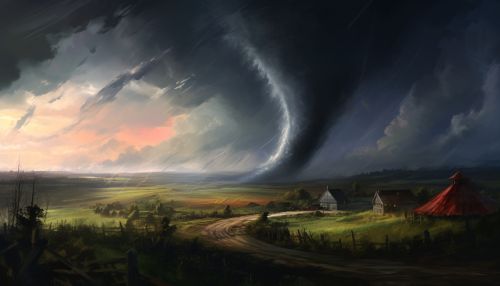The Science of Tornado Formation and Prediction
Introduction
Tornadoes, one of the most violent and unpredictable weather phenomena, have been a subject of scientific study for centuries. The science behind tornado formation and prediction involves a complex interplay of atmospheric conditions, meteorological processes, and advanced technology. This article delves into the intricate details of these processes, shedding light on the mechanisms that lead to the creation of a tornado and the methods employed to predict their occurrence.


Tornado Formation
Tornadoes are formed from powerful thunderstorms, specifically those classified as supercells. A supercell is a thunderstorm characterized by the presence of a mesocyclone, a deep, persistently rotating updraft. For a tornado to form, specific atmospheric conditions must be met.
Atmospheric Conditions
The first condition necessary for tornado formation is significant low-level moisture, typically found in warm, humid air masses. This moisture contributes to the instability of the atmosphere, a crucial factor in thunderstorm and tornado development. The second condition is atmospheric instability, which is the tendency for air parcels to accelerate when they are displaced from their original position. Instability is often measured by the Convective Available Potential Energy (CAPE).
The third condition is wind shear, which is the change in wind speed or direction with height. Wind shear can create a rotating column of air, or a vortex, which is a key component in the formation of a mesocyclone. The final condition is a lifting mechanism, such as a cold front or a dryline, which can force air upward and trigger thunderstorm development.
Mesocyclone Development
The development of a mesocyclone is a critical step in tornado formation. As the wind shear creates a horizontal spinning effect near the ground, the updraft of the thunderstorm tilts this horizontal rotation into a vertical orientation. This vertical rotation can then be stretched, causing it to spin faster and create a mesocyclone.
Tornado Genesis
The process of tornado genesis, or the creation of a tornado, is still not fully understood. However, it is known that not all mesocyclones produce tornadoes. For a tornado to form, additional processes within the mesocyclone are necessary. These may include the concentration of rotation near the ground, changes in the wind field, or interactions with the storm's Rear Flank Downdraft (RFD).
Tornado Prediction
Predicting tornadoes involves the use of sophisticated technology and a deep understanding of meteorological processes. Forecasters use a combination of observational data, numerical weather prediction models, and radar technology to predict the likelihood of tornado formation.
Observational Data
Meteorologists use observational data from weather stations, weather balloons, and satellites to assess the atmospheric conditions that may lead to tornado formation. This data includes measurements of temperature, humidity, wind speed and direction, and atmospheric pressure.
Numerical Weather Prediction Models
Numerical Weather Prediction (NWP) models are computer algorithms that simulate the atmosphere and predict its future state. These models use the laws of physics and initial observations of the atmosphere to forecast weather conditions. Some NWP models are specifically designed to predict severe weather and can provide valuable information about the potential for tornado formation.
Radar Technology
Radar technology, specifically Doppler Radar, is a crucial tool in tornado prediction. Doppler Radar can detect the rotation within a thunderstorm that may indicate the presence of a mesocyclone. In addition, the advent of Dual-Polarization Radar has improved tornado prediction by providing more detailed information about the precipitation within a storm.
Conclusion
The science of tornado formation and prediction is a complex field that requires a deep understanding of atmospheric processes and advanced technology. Despite the progress made in this field, predicting tornadoes with high accuracy remains a challenge due to the complex and chaotic nature of the atmosphere. Continued research and advancements in technology are crucial for improving our ability to predict these destructive weather phenomena.
